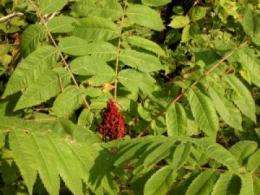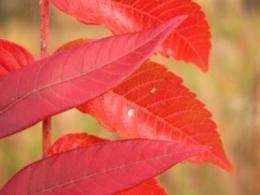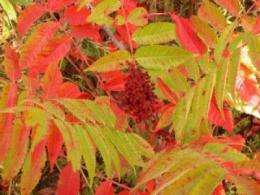Scientists are trying to save the critically endangered Michaux’s sumac -- one of the rarest shrubs in the southeastern United States -- but the plant is not cooperating. Credit: Lytton Musselman Old Dominion University
It is one of the rarest shrubs in the southeastern United States, and for scientists trying to save it, the critically endangered Michaux's sumac (Rhus michauxii) is not cooperating.
So far botanists have exposed the hard-, thick-coated seeds of this native North American plant to boiling water, dry heat up to 284 degrees Fahrenheit and flames from a propane blowtorch to try to coax them into germination. Nothing has worked.
"Complete understanding of the germination requirements of endangered plants is an absolute requirement to effectively manage populations," Smithsonian research associate Jay Bolin and botanists Marcus Jones and Lytton Musselman write in a recent paper on this plant in Native Plants Journal.
So far, however, Michaux's sumac has not given up its secrets.
Michaux's sumac is one of the rarest shrubs in the southeastern United States. The critically endangered plant is not cooperating with scientists who are trying to save it. Credit: Lytton J Musselman Old Dominion University
Because Michaux's sumac grows only in areas with few trees where the vegetation has been disturbed, it has long been assumed that its seeds germinate naturally following exposure to the high temperatures of a brush or forest fire. Decline of this plant has been attributed to the prevention and suppression of brush and forest fires by humans.
In Virginia it grows in only two places: on the grounds of the Virginia Army National Guard Maneuver Training Center in Fort Picket, and a mowed railway right-of-way in an undisclosed location.
In a recent series of germination experiments, the scientists exposed different sets of Michaux's sumac seeds to dry heat temperatures of 140, 176, 212, 248 and 284 degrees Fahrenheit, some sets for 5 minutes and other sets for 10 minutes. (The temperatures were determined based on maximum wildfire surface temperatures and burn times recorded in southeastern U.S. forests.)
The researchers found that temperatures above 212 degrees F. killed the seeds. Lower temperatures had virtually no impact on breaking the seed's dormancy.
Michaux's sumac is one of the rarest shrubs in the southeastern United States. The critically endangered plant is not cooperating with scientists who are trying to save it. Credit: Photo: Lytton J Musselman Old Dominion University
The highest germination rates—30 percent—occurred after sulfuric acid was poured on Michaux's sumac seeds and allowed to scarify (dissolve and weaken) the seed coats. This finding, from an experiment done in 1996, has led the researchers to their next experiment using birds.
"We are going to feed the seeds to quail and wild turkey to determine if that breaks the seed dormancy," says Bolin, a research associate with the Department of Botany at the Smithsonian's National Museum of Natural History and an assistant professor at Catawba College in Salisbury, N.C.
Seed passage through the digestive tracts of fruit-eating birds (and exposure to the acid in the bird's stomachs) may break the physical dormancy of these seeds and help disperse them as well, the scientists write.
More information: The paper "Germination of the federally endangered Michaux's sumac (Rhus michauxii)," authored by Jay F Bolin, Marcus E Jones (Norfolk Botanical Garden, Norfolk Va.,) and Lytton J Musselman (Old Dominion University, Norfolk, Va.) appeared in the Summer 2011 issue of Native Plants Journal.
Provided by Smithsonian























